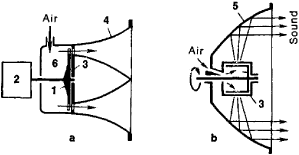siren
siren
[′sī·rən]siren
Siren
in ancient Greek mythology, a half-bird, half-woman. According to Homer’s Odyssey, the sirens used their enchanting voices to lure sailors to rocky shores, against which the sailors’ ships were smashed. In order to save his ship, Odysseus stopped his companions’ ears with wax and ordered himself tied to the mast. Similarly, Orpheus’ persuasive voice overcame the allure of the sirens and saved the Argonauts from death.
The ancient Greeks also believed that the sirens were associated with an underground kingdom, and as a result, the sirens were often depicted on gravestones. The most common type of sirens in ancient Greek art were creatures with the head and chest of a woman and the body of a bird. Figuratively, the term “siren” refers to a beautiful and seductive woman with an enchanting voice.
Siren
an acoustic radiator whose operation is based on the periodic interruption of a stream of gas or liquid. Liquid sirens do not differ in principle from gas sirens, but they are used comparatively rarely because of the difficulty in designing a mechanism for radiation into a medium with a high acoustic resistance.
Sirens are classified according to the principle of operation as dynamic (rotating) and pulsating. Dynamic sirens are the most widely used type and are subdivided into axial and radial sirens (Figure 1). In an axial siren the air stream coincides with the axis of rotation; in a radial siren the air stream is directed along a radius perpendicular to the axis. In axial sirens a perforated disk—the rotor—rotates relative to a stationary disk—the stator. In radial sirens the rotor and the stator are two coaxial, usually cylindrical, surfaces. The rotor is rotated by an electric motor or by a small gas turbine. Air from a chamber enters under pressure through the apertures in the rotor and stator and is periodically interrupted. The frequency of air pulsations f is determined by the number of apertures in the rotor or stator m and by the number of rotor revolutions per minute N:f= mN/60 hertz (Hz). The frequency f is the fundamental frequency in the sound spectrum being radiated by the siren. The frequency range of sirens used in actual practice ranges from 200-300 Hz to 80-100 kilohertz (kHz); however, some sirens operate at frequencies up to 600 kHz. The power rating of a siren may be as high as tens of kilowatts.

Dynamic air sirens are used for signaling, as in alarm and signal sirens, and for various technological purposes, including the coagulation of finely dispersed aerosols, defoaming, the precipitation of fogs, and the acceleration of heat-exchange and mass-exchange processes.
REFERENCES
Bergmann, L. Ul’trazvuk i ego primenenie ν nauke i lekhnike, 2nd ed. Moscow, 1957. (Translated from German.)Crawford, A. E. Ul’trazvukovaia tekhnika. Moscow, 1958. (Translated from English.)
Veller, V. A., and B. I. Stepanov. “Ul’trazvukovye sireny s privodom ot elektrodvigatelia.” Akusticheskii zhurnal, 1963, vol. 9, no. 3.
IU. IA. BORISOV [23–1333–]